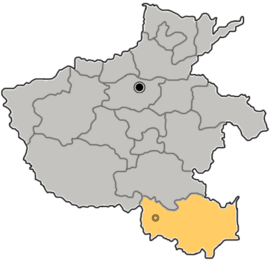Xinyang
| Basic data | |
|---|---|
| Greater Region: | Central China |
| Province : | Henan |
| Status: | District-free city |
| Area : | 18,819 km² |
| Residents : | approx. 6.11 million (2010 census) |
| Population density : | 418.2 inhabitants / km² |
| Subdivision: | 2 city districts, 8 districts |

|
|
Xinyang ( Chinese 信阳 市 , Pinyin Xìnyáng Shì ) is a district-free city in Henan Province , People's Republic of China . Your administrative area has an area of 18,819 square kilometers. At the 2010 census, the population was 6,109,106 people. 918,078 people live in the actual urban settlement area of Xinyang (2010 census).
geography
The city of Xinyang is located in the southeast of Henan Province on Huai He near the Dabie and Tongbai Mountains. Its administrative area is bordered by Zhumadian City to the north, Nanyang City to the northwest, Anhui Province to the east, and Hubei Province to the south .
Administrative structure
At the county level, Xinyang is made up of two boroughs and eight counties. These are:
- District Shihe (浉河区), 1,783 km², 610,000 inhabitants;
- Pingqiao District (平桥 区), 1,889 km², 770,000 inhabitants;
- Xi District (息 县), 1,836 km², 920,000 inhabitants
- Circle Huaibin (淮滨县), km² 1192, 660,000 inhabitants
- Huangchuan County (潢川 县), 1,638 km², 790,000 residents;
- County Guangshan (光山县), km² 1829, 790,000 inhabitants;
- Gushi district (固始 县), 2,916 km², 1.56 million inhabitants
- Shangcheng County (商城 县), 2,117 km², 710,000 inhabitants
- Luoshan County (罗山县), 2,065 km², 720,000 inhabitants
- Xin County (新 县), 1,554 km², 340,000 inhabitants.
A new government and business district is currently being built in the Pingqiao District. The gigantic construction project is entitled "New Yangshan District" (羊山 新区). But this is - at least so far - not a new city district in the administrative sense.
Culture and sights
Changtaiguan (长 台 关 乡) is an important archeological community in the Pingqiao district . The excavation site was named after the site Changtaiguan Chumu ( Chinese 長 台 關 楚 簡 / 长 台 关 楚 简 - "Chu graves from Changtaiguan"). In 2006 Changtaiguan was the municipality Changtai renamed (长台乡).
The Chu grave, excavated from 1957 to 1958, contained, among other things, bamboo texts , lacquerware and musical instruments.
Two graves from the Warring States Period were uncovered . In particular, the finds with Confucian texts from grave no. 1 have aroused great interest.
Over 100 written bamboo tablets were discovered. One of the texts was a "grave inventory" (qiǎncè 遣 策), on which the names of the grave goods are recorded.
sons and daughters of the town
- Han Suyin (1917–2012), doctor and writer
- Jia Zhanbo (* 1974), marksman
literature
- Liu Yu: "Xinyang Chu jian shiwen yu kaoshi" (translation and investigation of the Chu period bamboo tablets from Xinyang), in: Xinyang Chu mu (The Chu tomb of Xinyang) 1986: 124-37
- Zhongguo da baike quanshu : Kaoguxue (archeology). Beijing: Zhongguo da baike quanshu chubanshe, 1986
Web links
Coordinates: 32 ° 8 ' N , 114 ° 3' E